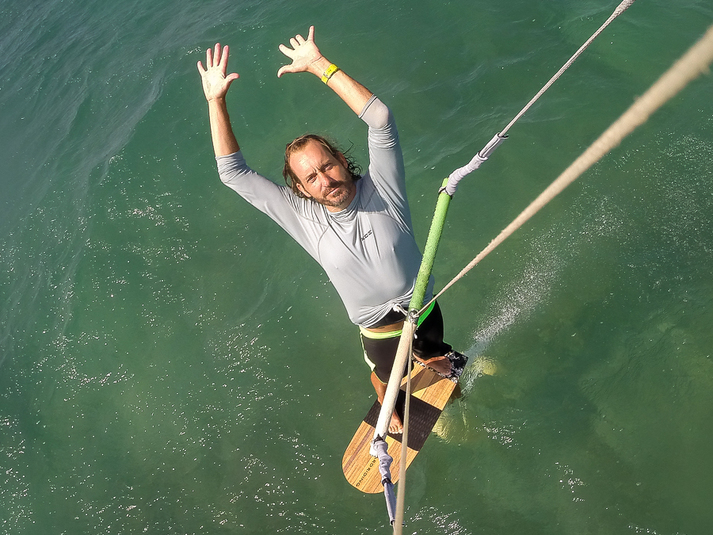Board Riding Maui’s Cloud Connection System

The other day Steve said:
Ok, I'm late to the party, can you send me a picture of your bar setup that is
similar to the BRM bar? I'm putting a bar together, thinking of going with
something like BRM, but might just go with a separate flag line that runs
through the bar (and is attached to a top line 10m up or so)...
The mention of the Board Riding Maui bar–the Cloud Connection System or CCS–reminded me how impressed I am with that design. I rewatched the 2015 video about the CCS and then I wrote the following tome for Steve. For those that don’t know me, understand that I am a land kiter. Specifically, I’m a buggy rider. So temper your opinions of my opinions with that. Steve kites on both land and water. He’s amphibious.
There’s a lot to like about the CCS
Greg’s point about moving the bar closer to your body is perhaps the most important thing in his entire pitch. Every millimeter from you to the pulled-in bar is bar throw wasted. He is right that it is especially hard on women, but the additional reach benefits everyone no matter how long their arms. The bar hook and chicken loop system is for a particular audience. If you are not part of that audience, then say goodbye to the Hook and Loop. This of course exposes you to the problem of how to source gear as Hook and Loop is most of the market, but the first step is always to admit you have a problem.
After that, I really admire the simplicity of what he was designed. It has all the safety features of modern kite boarding gear and then some. The massive travel on the bar provides a good margin of safety. The first release is simple, low tech and has good odds of a clean release. The second release is just as low tech and physically very close to the first. It’s nice design that should reduce the risk of operator error in crisis.
Yet it all of this is done with very simple hardware. It’s so simple it would be easy to make a reasonable clone with cheap parts and minimal tools. The most exotic parts are the pins in the quick releases, yet even those could be made with stainless steel cotter pins from the local hardware store. The balls in the QR are probably custom, but they would be reasonably simple to machine or 3-D print.
The balls are secured to the lines by doubling the line they ride along, tying a knot above and below the ball and running a cord through the center of the ball and between the pair of lines. It’s an ingeniously simple design that’s easy to make, assemble and field service.
I agree with his assertions about the value of low mass on the bar ends, though my motivations may be different. I like the low mass from a standpoint of rapid acceleration and deceleration when spinning the bar. Heavier ends means it can hit your fingers harder in a spin. His design cannot be spun in the conventional sense. As he says, you have to turn it hand over hand, yet the rule might apply for the same reason. After all, a hand-over-hand spin would need to be quick as well.
I agree with his assertions about the embroidery on the bar cover. Having a tactile difference between left and right would be valuable. A non-visual cue could reduce the risk of grabbing the bar backwards. It’s a feature I would like to add to my own design if I can think of a way to do it that doesn’t compromise the feel of the smooth wood.
How I feel differently
What I would not like about the CCS is the lack of dynamic trim control. Greg’s opinions on trim control seem to be tied completely into the measures of kite size and rider arm length; undoubtedly these are constants for a session. If those were the only cause for trim changes then I would agree with him, but that’s not been my experience. Whereas kite size and arm length are factors, they don’t tell the whole story for me. I adjust trim in flight for three reasons that have little to do with Greg’s motivations.
My first cause for trim change is kite size vs wind speed. If I am flying with too much sail I trim in. If my kite is “right-sized” I trim out. You could argue that I should fly the “right” size all the time, but “right” is relative. I usually don’t like being over-powered, but sometimes it is a heck of a lot of fun. When I want to taste the over-power I can fly a larger kite and trim in to minimize my slide and bodily abuse. When I want to pour on the juice I trim out and can finish a run with a massive power-slide in the sand. It’s great fun and it’s a great show if you have spectators.
The second scenario in which I change trim is upwind tack vs downwind tack. I almost always trim out for downwind and then trim back in for upwind. I’ll do this over and over tweaking the trim just before or just after coming about. You have a few seconds to make these trim changes before you are either over-powered starting an upwind tack or under-powered starting a downwind tack. If I don’t make these trim changes, the bar is not in a good range for sheeting in or out for normal manuevers while on a tack.
In each of these scenarios it’s not impossible to make the kite work without the trim change, but the range of the bar is compromised if you don’t adjust the trim. I am not one to work my kites when I am cruising, but I do a lot of beach flying and that often demands repeated tacks and jibes. If you are not optimized to work the kite in those manuevers you’ll lose velocity made good at every turn.
Understand that I say this about my experience with bars that provide a lot of bar throw. In my rigs I have dispensed with the chicken loop and hook. My bars use a double trim line that allows the back of the bar to reach within an inch of the QR snaphook attached to my harness. The snaphook is the smallest I can source. It’s sewn directly into a custom swiss seat designed to get the hook as low as possible. At the other end of the bar’s travel, I position the trimline cleat at the limit of what I can reach. I minimize the hardware between the bar and the cleat so I can maximize the bar travel. These features give me a lot of travel, and yet I still feel the need to trim the bar to a point where it settles in near the center of the throw for steady-state flying.
My last reason for trimming is for a comfortable reach to the bar. I generally do not rest the bar on the stopper ball. I hold the bar with my fingers straddling the trim line. This let’s me one-hand-fly. I steer with tiny adjustments of finger pressure above or below the trim line. I make small and rapid adjustments to trim to accommodate gusts and other changing conditions. To do this for any length of time the bar can’t be way out or way in. Either extreme can be very uncomfortable on a long tack. So I trim the bar so it can settle a comfortable distance from me near the middle of the bar’s throw.
I don’t think the features I like in my rig can be adapted to the CCS. Adding trim control below the bar robs you of bar travel. That forces the trim control above the bar and above the top of the bar’s travel. The complexity required to do trim control above the bar would rob the CCS of its fantastic simplicity and clean release paths. I think you have to choose one course or the other. Each has advantages.
